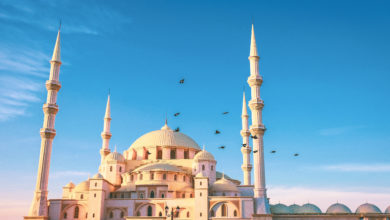The Faisal Mosque (Urdu: فیصل مسجد, romanized: Masjid Fayṣal) is a mosque in Islamabad, Pakistan. It is located on the foothills of Margalla Hills in Islamabad. This mosque features a contemporary design consisting of eight sides of concrete shell and is inspired by a Bedouin tent.
The Faisal Mosque can accommodate about 300,000 worshippers. Each of the Mosque’s four minarets are 79 m (259 ft) high (the tallest minarets in South Asia) and measure 10×10 metres in circumference.
This mosque is a major tourist attraction in Pakistan, Islamabad in particular, and is referred as a contemporary and influential feature of Islamic architecture.
Construction of the mosque began in 1976 after a $120 million grant from Saudi King Faisal, whose name the mosque bears. The unconventional design by Turkish architect Vedat Dalokay was selected after an international competition. Without a typical dome, the mosque is shaped like a Bedouin tent, surrounded by four 260 feet (79 m) tall minarets. The design features eight-sided shell shaped sloping roofs forming a triangular worship hall which can hold 10,000 worshippers.
Combined the structure covers an area of 54,000 square ft, the mosque dominates the landscape of Islamabad. It is situated at the north end of Faisal Avenue, putting it at the northernmost end of the city and at the foot of Margalla Hills, the westernmost foothills of the Himalayas. It is located on an elevated area of land against a picturesque backdrop of the national park. The largest mosque in Pakistan, the Faisal Mosque was the largest mosque in the world from 1986 until 1993, when it was overtaken by mosques in MENA region of Saudi Arabia. Faisal Mosque is now the fourth largest mosque in terms of capacity.
The impetus for the mosque began in 1966 when King Faisal bin Abdul-Aziz supported the initiative of the Pakistani Government to build a national mosque in Islamabad during an official visit to Pakistan. In 1969, an international competition was held in which architects from 17 countries submitted 43 proposals.
The winning design was that of Turkish architect Vedat Dalokay. Forty-six acres of land were assigned for the project and the execution was assigned to Pakistani engineer and workers. Construction of the mosque began in 1976 by National Construction Limited of Pakistan, led by Azim Khan and was funded by the government of Saudi Arabia, at a cost of over 130 million Saudi riyals (approximately 120 million USD today).
King Faisal bin Abdul Aziz was instrumental in the funding, and both the mosque and the road leading to it were named after him after his assassination in 1975. King Faisal bin Abdul-Aziz’s successor Shah Khalid laid the foundation stone for the mosque in October 1976 and signed the construction agreement in 1978.
Basic information of the mosque can be found written on the foundation stone. On 18 June 1988, the first prayer was held, although the mosque was completed in 1986. The mosque grounds along with being a building for prayer, also used to house the International Islamic University some years ago but has since relocated to a new campus in 2000.
Architecture
I tried to capture the spirit, proportion and geometry of Kaaba in a purely abstract manner. Imagine the apex of each of the four minarets as a scaled explosion of four highest corners of Kaaba – thus an unseen Kaaba form is bounded by the minarets at the four corners in a proportion of height to base. Shah Faisal Mosque is akin to the Holy Kaaba in the designer’s imaginative eyes. Now, if you join the apex of each minaret to the base of the minaret diagonally opposite to it correspondingly, a four-sided pyramid shall be bound by these lines at the base side within that invisible cube. That lower level pyramid is treated as a solid body while four minarets with their apex complete the imaginary cube of Kaaba.
— Vedat Dalokay, “Dalokay further explains the thinking behind the design of the Masjid to students of a design school”
Instead of using traditional domes, Vedat Dalokay designed an eight sided main hall that looked like an Arab’s Bedouin desert tent.
Additionally, he added four minarets on all four corners of the main hall, which are of 80 m (260 ft) high, the tallest minarets in South Asia. The main structure of the building is the main prayer hall, which is supported by four concrete girders.
The four unusual minarets are inspired by Turkish architecture. Vedat Dalokay also believed that the design of the Masjid represents Kaaba in an abstract manner. Entrance is from the east, where the prayer hall is fronted by a courtyard with porticoes.
The International Islamic University was housed under the main courtyard, but now has relocated to a new campus. The mosque still houses a library, lecture hall, museum and cafe. The interior of the main tent-shaped hall is covered in white marble and decorated with mosaics and calligraphy by the famous Pakistani artist Sadequain, and a spectacular Turkish-style chandelier. The mosaic pattern adorns the west wall, and has the Kalimah written in early Kufic script, repeated in mirror image pattern.


